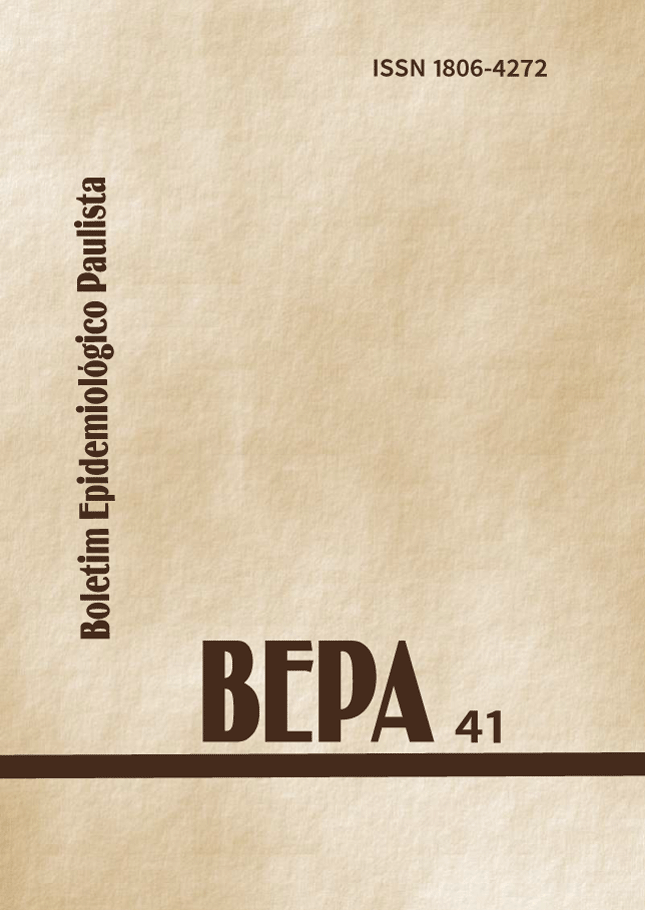Abstract
The laboratorial ante-mortem diagnosis of human rabies include the detection of rabies virus in skin biopsy, saliva, cerebrospinal fluid (CSF), corneal smear and also the detection of rabies virus-neutralizing antibodies (VNA) in serum or CSF samples. The detection of rabies VNA in the serum or CSF of unvaccinated individuals is diagnostic of rabies, but it occurs late in course of the disease. In this study were analyzed the results of VNA in serum and /or CSF of three cases of patients suspect of rabies, with no history of previous vaccination or passive immunization. The VNA evaluation was performed by the simplified fluorescence inhibition microtest. The patient A received diagnostic of rabies, despite of there wasn’t analyses of central nervous system (CNS), supported by the clinical symptoms and results of VNA titers of 3,0 IU/mL in serum and 0,37 IU/mL in CSF. About the two patients who had the rabies virus identified for the techniques post-mortem in the CNS, the patient B presented 12 IU/mL of VNA in CSF and the patient C had negative results of VNA titers in serum and CSF samples, which were compatible to period of morbidity. These results indicated that the determination of VNA in serum and CSF samples of rabies human suspect cases, with no history of previous vaccination or passive immunization should contribute to ante-mortem diagnosis if successive collects were done to evaluate the progression of VNA titers establishing more safety in diagnostic, especially in those cases that the brain tissue can be collected for any reason.
References
CDC. Centers for Disease Control and Prevention. Human Rabies Prevention – United States, 1999. Recommendations of the Advisory Committee on Immunization Practices (ACIP). MMWR 1999 jan 8; 48 (RR-1): 1-21.
Constantine DG. Rabies transmission by no byte route. Public Health Rep. 1962, 77:287-289.
CDC. Centers for Disease Control and Prevention. Investigation of rabies infections in organ donor and transplant recipients-Alabama, Arkansas, Oklahoma, and Texas, 2004. MMWR 2004 jul 9; 53(26):586- 589.
Bronnert J, Wilde H, Tepsumethanon V, Lumlertdacha B, Hemachudha T. Organ Transplantations and Rabies Transmission. J Travel Med. 2007; 14(3):177–180.
WHO. World Health Organization. Rabies. Disponível em: http:/www.who.int/mediacentre/factsheets/ fs099 [2006 dezembro 22].
MS. Ministério da Saúde. Dados sobre a raiva. Disponível em: http://portal.saude.gov.br/portal/arquivos/ pdf/raiva_2006.pdf [2007 abril 08].
WHO. World Health Organization. Intra-vitam diagnosis. Disponível em: http://www.who.int/rabies/human/ intra_vitam/en/print.html [2007 maio 07].
Murphy FA. Rabies Pathogenesis. Arch Virol. 1977; 54:279-297.
Hattwick MAW, Gregg MB. The disease in man. In: Baer GM. ed. The Natural History of Rabies 1975; Vol II: p.281-305.
WHO. World Health Organization. Expert Committee on Rabies. Eighth report. WHO Technical Report Series; 824. Geneva 1992.
Warrell MJ, Warrell DA. Rabies and other lyssavirus diseases. The Lancet 2004 mar 20; 363:959-969.
Crepin P, Audry L, Rotyvel Y, Gacoin A, Carroff C, Bourhy H. Intravitam diagnosis of human rabies by PCR using saliva and cerebrospinal fluid. J Clin Microbiol. 1998; 36(4):1117-1121 ::
Dean DJ, Abelseth MK, Atanasiu P. The fluorescent antibody test In: Meslin FX, Kaplan MM, Koprowsky H. Laboratory techniques in rabies 1996. Genebra: World Health Organization; p. 88-95.
Koprowsky H. The mouse inoculation test. In: Meslin FX, Kaplan MM, Koprowsky H. Laboratory techniques in rabies 1996. Genebra: World Health Organization; p. 80-87.
Favoretto SR, Carrieri ML, Tino MS, Zanetti. CR, Pereira OAC. Simplified fluorescence inhibition microtest for the detection of rabies neutralizing antibodies. Rev Inst Med trop S Paulo 1993; 35:171- 175.
Rupprecht CE. Rhabdoviruses: Rabies Virus. In: Baron S, Peake RC, James DA, Susman M, Kennedy CA, Singleton MJD, Schuenke S. Medical Microbiology. Fourth Edition. The University of Texas Medical Branch at Galveston, 1996. Disponível em: http://www.ncbi.nlm.nih.gov/books. [2007 maio]
Rupprecht CE, Hanlon CA, Hemachudha T. Rabies re-examined. The Lancet Infec Dis 2002 June 2; 327-343. Disponível em: http://infection.thelancet.com
CDC. Centers for Disease Control and Prevention. Rabies in a laboratory worker – New York. MMWR 1977; 26:183-184.
Hattwick MA, Weis TT, Stechschulte CJ, Baer GM, Gregg MB. Recovery from rabies. A case report. Ann Intern Med. 1972; 76:931-942.
Porras C, Barboza JJ, Fuenzalida E, Adaros HL, Oviedo AM, Furst J. Recovery from rabies in man. Ann Intern Med. 1976; 85: 44-48.
Alvarez L, Fajardo R, Lopez E, Pedroza R, Hemachudha T, Kamolvarin N, Cortes G, Baer GM. Partial recovery from rabies in a nine-year-old boy. Pediatr Infect Dis J. 1994; 13:1154-1155.
Madhusudana SN, Nagaraj D, Uday M, Ratnavalli E, Kumar MV. Partial recovery from rabies in a six-yearold girl. Int J Infect Dis. 2002; 6:85-86.
CDC. Centers for Disease Control and Prevention. Recovery of a Patient from Clinical Rabies - Wisconsin, 2004. MMWR 2004; 53 (50):1171-1173.
]24. CDC. Centers for Disease Control and Prevention. Imported human Rabies- France, 1992. MMWR 1992 december; 41(51):953-955.
CDC. Centers for Disease Control and Prevention. Human Rabies – Tennessee, 2002. MMWR 2002 september 20; 51(37):828-829.
Hemachudha T, Wacharapluesadee S. Antemortem diagnosis of human rabies. Clin Infect Dis. 2004; 39:1085-1086.

This work is licensed under a Creative Commons Attribution 4.0 International License.
Copyright (c) 2007 Luciana Botelho Chaves, Andréa de Cássia Rodrigues Silva, Graciane Maria Medeiros Caporale, Karin Corrêa Scheffer, Salim Jorge Waquim Neto, Maria Luiza Carrieri, Ivanete Kotait
